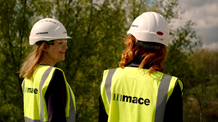How decarbonisation funding initiatives can drive the Levelling Up agenda
The government’s 2019 manifesto commitment to build 300,000 new homes a year has been in dispute across 2022.
Ex-housing minister Lee Rowley confirmed during the Conservative Party conference that former prime minister Liz Truss wished to abolish “top-down housing targets”, although exact government property policies are not yet clear now Rishi Sunak has stepped into the top spot. Despite these comments, however, returning secretary of state for levelling up, housing and communities Michael Gove clearly recommitted to the target in October.
Regardless of whether the 300,000-new-homes target is hit, ministers need to be more forthcoming about how we ensure delivery of the building stock that we need across the UK.
This is essential for residential properties, but businesses also need to be confident that commercial spaces are available as well.
Against the backdrop of net zero, rising energy bills and record interest rates, the government cannot afford to focus only on new build. Everything possible must be done to ensure that new buildings have low emissions, along with facilities and infrastructure to help communities and businesses adopt more sustainable practices. However, it is essential that the stock we build today does not become the retrofit project of the future.
With leaky buildings up and down the UK crying out for energy efficiency upgrades, the bigger challenges for ministers are the millions of retrofit projects of the present up and down the UK. Indeed, with 80% of the UK’s building stock by 2050 already built, failing to tackle this would make achieving net zero practically impossible.
Retrofitting barriers
Earlier this year, the Building Back Britain Commission reported the scale of the challenge with our existing buildings. While the government’s aspiration is for as many homes as possible to be EPC band ‘C’ by 2035, the reality is that far too many buildings are simply not hitting this standard. In the average English local authority, 58% of homes are presently below EPC band ‘C’.
A common major barrier to upgrading such homes is that the cost of decarbonisation measures would exceed the potential price gain, a problem exacerbated by a drop in house prices following Liz Truss’s mini-Budget. Often these buildings are in local authorities that have been designated by the government as levelling-up priority areas, where properties could be lower value.
This issue applies to both residential and commercial building stock. No business is happy putting up with higher utility costs due to energy leaks from their estates, but even works to lower ongoing costs need a robust business case to ensure confident delivery.
While the owners of inefficient properties could embark on extensive decarbonisation upgrades that would lead to lower fuel bills, the reality is that most will find it very difficult without some form of government subsidy.
To break the deadlock, the commission has proposed that government should look at providing property owners with 100% government grants funded via public borrowing. The VAT cuts on green measures that came into effect in April are welcome, but more should be done.
That means a multi-billion-pound investment programme over the next 10 years to ensure that energy efficiency upgrades take place in millions of properties that would otherwise miss out. Both residential and commercial building owners should be offered access to such funding, since the challenge of shoring against rising bills faces them both.
Decarbonisation challenge
The scale of these calls for investment may raise eyebrows in government, with anticipated capital spending cuts and tax rises in the upcoming Autumn Statement.
However, Sunak’s new government should recognise the wider benefits of committing funding for these works for driving the levelling-up agenda, as well as supporting his commitments made during COP27. Retrofitting works create job opportunities that give local people the chance to develop new skills. These are highly transferrable and can drive a range of works required to decarbonise a community.
Alongside the job opportunities created by decarbonisation works, by lowering utility bills for residents and businesses we can help boost spending in local economies. For businesses, having the confidence and freedom to invest in growing their operations, beyond merely ‘keeping the lights on’, can dramatically increase their ability to both support smaller enterprises and provide greater opportunities for local people.
With a recession looming amid spiking inflation, this could become even more important. Immediate investment to upgrade our inefficient building stock is the path ministers must take if we are to make real progress on net zero and the cost of living, as well as levelling up. In this way, it could provide a silver lining to the disruption caused by the upcoming economic turbulence.
This article was first published in Property Week.












